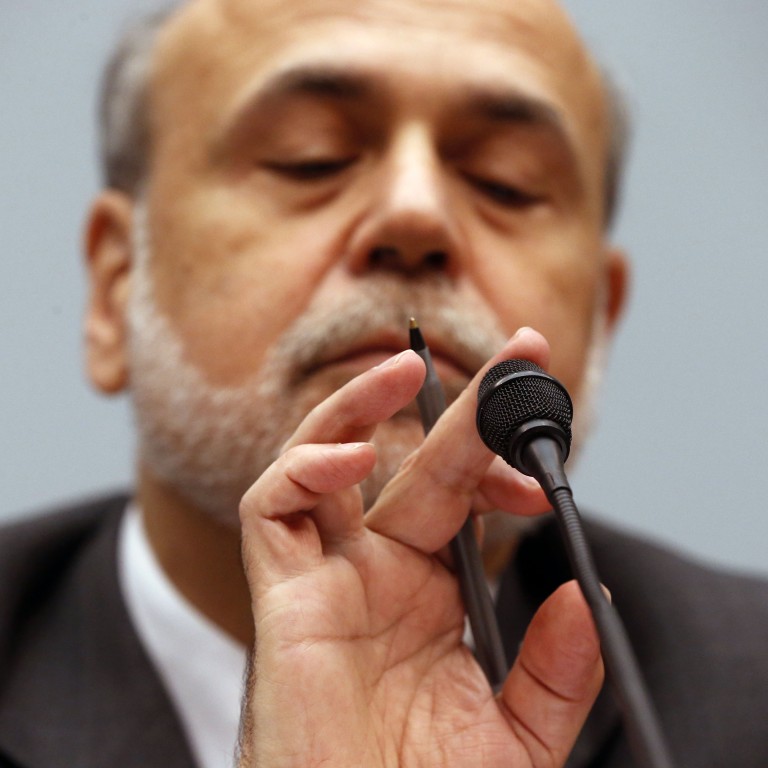
Update | Fed surprises markets, sticking with stimulus as growth outlook falls
The US Federal Reserve said it would continue buying bonds at a US$85 billion monthly pace for now, surprising financial markets that were braced for a reduction in the central bank's economic stimulus.
The US Federal Reserve defied investor expectations on Wednesday by postponing the start of the wind down of its massive monetary stimulus, saying it wanted to wait for more evidence of solid economic growth.
Investors responded by propelling US stocks to record highs and driving down bond yields. Yields on US Treasury debt had risen over the summer on expectations the Fed would cut back its US$85 billion a month in bond purchases that have been the cornerstone of its efforts to spur the economy.
Furthermore, Fed Chairman Ben Bernanke refused to commit to begin reducing the bond purchases this year, and instead went out of his way to stress the program was “not on a preset course.” In June he had said the Fed expected to cut back before year end.
“There is no fixed calendar schedule. I really have to emphasise that,” he told a news conference. “If the data confirm our basic outlook, if we gain more confidence in that outlook ... then we could move later this year.”
The reaction in markets was swift and sharp. The US dollar fell to a seven-month low against major currencies and the price of gold, a traditional inflation hedge, soared more than 4.0 per cent.
“The Federal Reserve remains quite concerned about the overall sluggishness of the economy, preferring to take the risk of being too loose for too long as opposed to tighten prematurely,” said Mohamed El-Erian, co-chief investment officer at Pimco, which manages the world’s largest mutual fund.
Some economists said it was possible the Fed might not begin to wind down its bond buying until after Bernanke’s term as Fed chairman expires in January. That would leave the tricky task of unwinding the stimulus to his successor, quite possibly Fed Vice Chair Janet Yellen who was identified by a White House official on Wednesday as the front-runner for the job.
Bernanke declined to comment on his own future, beyond saying he hoped to have more information soon.
In fresh quarterly forecasts, the Fed cut its forecast for this year economic growth to a 2.0 per cent to 2.3 per cent range from a June estimate of 2.3 per cent to 2.6 per cent. The downgrade for next year was even sharper.
It cited strains in the economy from tight fiscal policy and higher mortgage rates, as it explained why it decided to maintain asset purchases at the current pace of US$85 billion a month.
“The tightening of financial conditions observed in recent months, if sustained, could slow the pace of improvement in the economy and labour market,” the Fed said in a statement.
Nevertheless, the Fed said the economy was still making progress despite tax hikes and budget cuts in Washington as a result of the so-called “sequester” implemented by Congress earlier this year.
“Taking into account the extent of federal fiscal retrenchment, the committee sees the improvement in economic activity and labour market conditions since it began its asset purchase program a year ago as consistent with growing underlying strength in the broader economy,” it said.
“The (policy-setting) committee decided to await more evidence that progress will be sustained before adjusting the pace of its purchases,” the Fed added.
Bernanke had stated in June that officials expected to begin slowing the pace of bond purchases later this year and would likely end the program by mid-next year, at which point the central bank forecast the unemployment rate would be around 7.0 per cent.
In his statement on Wednesday, he said a jobless rate of 7.0 per cent was not a “magic number” that would govern when the Fed would turn off the monetary spigot.
“We could begin later this year. But even if we do that, the subsequent steps will be dependent on continued progress in the economy,” Bernanke said. “We don’t have a fixed calendar schedule. But we do have the same basic framework that I described in June.”
The Fed has held overnight interest rates near zero since late 2008 and has more than tripled its balanced sheet to more than US$3.6 trillion through three rounds of bond buying aimed at holding borrowing costs down.
The decision not to taper bond purchases faced a single dissent, from Kansas City Federal Reserve Bank President Esther George, who said she was worried about financial bubbles due to the Fed’s low rate policy. George has dissented at every Fed policy meeting this year.
Fed Governor Sarah Raskin, who has been nominated to take a top job at the US Treasury, did not participate.
The Fed reiterated that it would not start to raise interest rates at least until unemployment falls to 6.5 per cent, as long as inflation does not threaten to go above 2.5 per cent. The US jobless rate in August was 7.3 per cent.
Most policymakers, 12 out of 17, projected the first rate hike would not come until 2015, even though the forecasts suggested they would likely hit their threshold for considering a rate rise as early as next year.
Following the unexpected decision, market participants pushed back their projections for the first rate hike by several months, to late January 2015, based on prices of interest rates contracts traded at the Chicago Board of Trade.
Reuters

